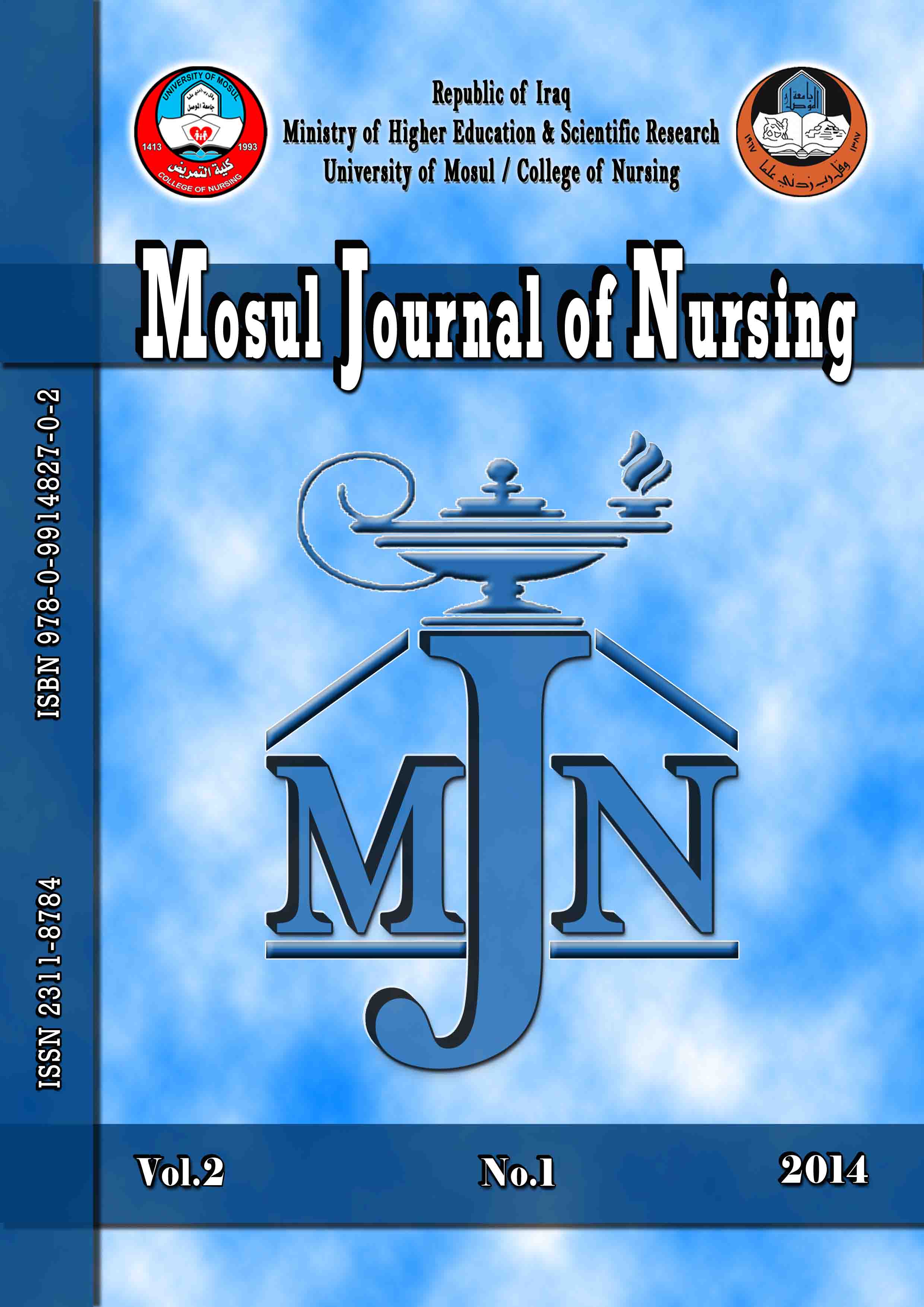Abstract
The aim of the study was to assess health problems related to Health Related of Quality of Life
(HRQoL) of diabetic patients Type-1-, and to identify the relationship between some
characteristics of diabetic patients Type-1- and health problems related to quality of life. This
study uses the purposive approach. The study was conducted at Ibn-Sina hospital in Mosul
city. The discruptive sample consists of (600) patients who visited Ibn-Sina hospital. In order
to collect the study information, a questionnaire was constructed depending on previous
studies and related literature review. It is composed of two parts: part one included (6) items
which focus on the diabetic patients demographic characteristics such as (sex, age, marital
status, occupation, educational level and residence). Part two was composed of (5) main items
that covered independency, daily physical activities, psycho-social aspects, beliefs and
environment. The total questions included (80) items, three scale options were used in the
rating scale: (0) for never, (1) for sometimes and (2) for always. Content validity was
determined by presenting the questionnaire to a panel of (12) experts. Internal consistency of
the questionnaire was assessed by calculating Cronbach's Coefficient alpha. The data analysis
shows that there is a significant statistical association between (HRQoL) items that are related
to independency, daily physical activities, psycho-social aspects, beliefs and environment
domains. The researcher concluded that (HRQoL) can be measured by instrument and that
diabetic patients' independency, daily physical activities, psycho-social aspects, beliefs and
environment were affected by their demographic characteristics (sex, age, marital status,
occupation, educational level and residence). Depending on the findings and conclusions of
the study, the researcher recommended further studies which could improve the instrument of
this study from the view point of validity, reliability, and quality of questions.
(HRQoL) of diabetic patients Type-1-, and to identify the relationship between some
characteristics of diabetic patients Type-1- and health problems related to quality of life. This
study uses the purposive approach. The study was conducted at Ibn-Sina hospital in Mosul
city. The discruptive sample consists of (600) patients who visited Ibn-Sina hospital. In order
to collect the study information, a questionnaire was constructed depending on previous
studies and related literature review. It is composed of two parts: part one included (6) items
which focus on the diabetic patients demographic characteristics such as (sex, age, marital
status, occupation, educational level and residence). Part two was composed of (5) main items
that covered independency, daily physical activities, psycho-social aspects, beliefs and
environment. The total questions included (80) items, three scale options were used in the
rating scale: (0) for never, (1) for sometimes and (2) for always. Content validity was
determined by presenting the questionnaire to a panel of (12) experts. Internal consistency of
the questionnaire was assessed by calculating Cronbach's Coefficient alpha. The data analysis
shows that there is a significant statistical association between (HRQoL) items that are related
to independency, daily physical activities, psycho-social aspects, beliefs and environment
domains. The researcher concluded that (HRQoL) can be measured by instrument and that
diabetic patients' independency, daily physical activities, psycho-social aspects, beliefs and
environment were affected by their demographic characteristics (sex, age, marital status,
occupation, educational level and residence). Depending on the findings and conclusions of
the study, the researcher recommended further studies which could improve the instrument of
this study from the view point of validity, reliability, and quality of questions.
Abstract
هدف الدراسة هو تقیم المشاکل الصحیة المتعلقة بنوعیة الحیاة لمرضى السکری النوع الأول وتحدید العلاقة بین بعض صفات المریض مع المشاکل الصحیة المتعلقة بنوعیة الحیاة. استخدمت هذه الدراسة المدخل الغیر تجریبی النوع الوصفی. ونظمت الدراسة فی مستشفى ابن سینا التعلیمی مدینة الموصل. وتتکون العینة العمدیة من (600) مریض الذین یزورون مستشفى ابن سینا التعلیمی ولجمع معلومات الدراسة فقد بُنی الاستبیان معتمداً على الدراسات السابقة وعلى استعراض المصادر المتعلقة بالموضوع. یتألف الاستبیان من جزئین: تضمن الجزء الأول (6) فقرات والتی رکزت على الصفات الدیموغرافیة لمرضى السکری مثل ( الجنس, العمر، الحالة الاجتماعیة, المهنة, التحصیل الدراسی والسکن). وتألف الجزء الثانی من (5) فقرات رئیسیة التی شملت الاستقلالیة, النشاطات الجسمیة الیومیة, الجوانب الاجتماعیة - النفسیة، المعتقدات والبیئة). وتضمنت مجموع الأسئلة (80) فقرة, حیث استخدمت ثلاث اختبارات معیاریة فی تقدیر المقیاس : الرقم (2) یعنی نعم, والرقم (1) یعنی أحیانا, والرقم (0) یعنی کلا. وتحددت مصداقیة المحتوى بواسطة عرض الاستبیان على هیئة تتألف من (12) خبیر. وقد قیم الثبات الداخلی للاستبیان بواسطة حساب معامل الارتباط کرونباج إلفا. أظهرت تحلیل البیانات أن هناک ترابط إحصائی معنوی لفقرات المشاکل الصحیة المتعلقة بنوعیة الحیاة: الاستقلالیة, النشاطات الجسمیة الیومیة, الجوانب الاجتماعیة – النفسیة، المعتقدات والبیئة. أستنتج الباحث أن الصحة المتعلقة بنوعیة الحیاة ممکن أن تقاس بواسطة أدوات ,استقلالیة مرضى السکری والنشاطات الجسمیة الیومیة, الجوانب الاجتماعیة – النفسیة، المعتقدات والبیئة وتأثرت بصفاتهم الدیموغرافیة (الجنس, العمر، الحالة الاجتماعیة, المهنة، التحصیل الدراسی والسکن) بالاعتماد على النتائج والاستنتاجات لهذه الدراسة, أوصى الباحث بدراسات أخرى التی ستُحسن الأداة المبینة عن طریق هذه الدراسة من جوانب المصداقیة والثبات ونوعیة الأسئلة.
